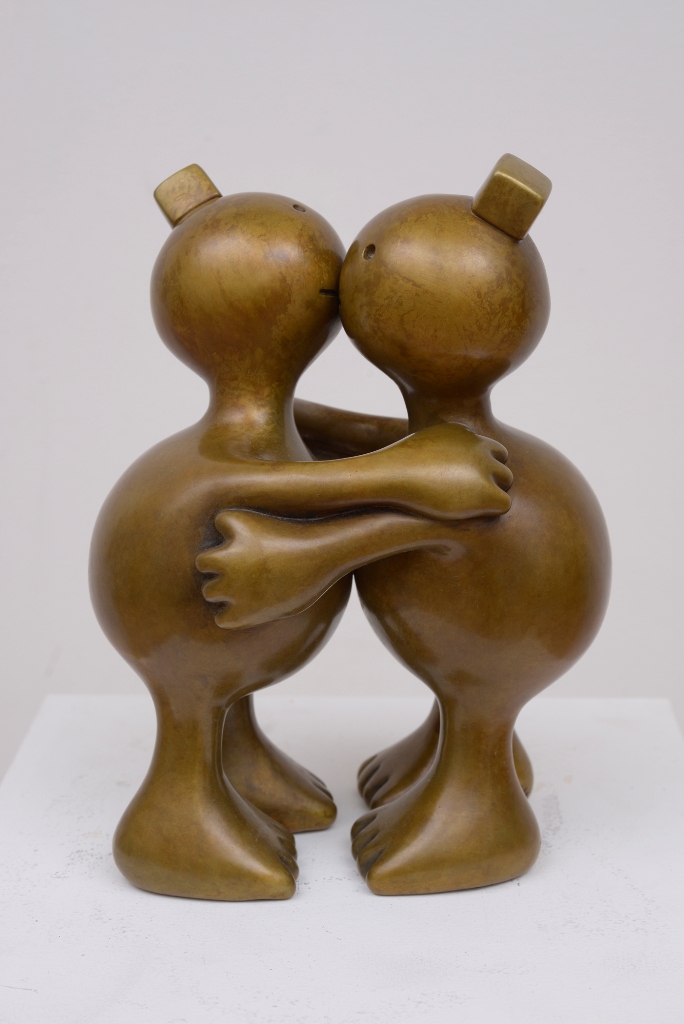
21 Sep TIO NYC: Fall Happenings, Wrap Up!
We hit the ground running (per usual) in New York, where the fall season is just getting started. Regardless, Chelsea is already setting the Pace (literally at “Super Pace”) and Broadway is on fire with plays like “Hadestown” and “Betrayal,” deep, dark tales that reflect the zeitgeist. That said, Tom Otterness’ latest show at the Marlboro Gallery, 40 West 57 Street, is a must. Filled with pathos, his pudgy bronze cartoon characters are an antidote to the headlines.
Among the Chelsea galleries not to miss (per our artist friend Matt Kleberg (whose own show is now up at the Gemini Gallery) are: David Zwirner, 537 West 20; Tanya Bonakchar, 521 West 21; Gladstone, 530 west 21; Lisson, 138 10th Avenue; Houser & Wirth, 548 West 22; Luhring Augustine, 531 W 24; and Pace, 540 West 25.
Highlights below.

“Tipping Point,” Tom Otterness, now up at the Marlborough Gallery..
Fred Wilson was born in the Bronx in 1954, and continues to live and work in New York. The artist received a BFA from Purchase College, State University of New York. With regard to his unorthodox artistic practice, Wilson has said that, although he studied art, he no longer has a strong desire to make things with his hands.
“I get everything that satisfies my soul from bringing together objects that are in the world, manipulating them, working with spatial arrangements, and having things presented in the way I want to see them.”
Like the way his chandeliers are displayed at the Pace Gallery’s brand new flagship space at 540 West 25th Street in Chelsea, dubbed “Super Pace.” which opened on September 20:
“Spanning eight stories and measuring approximately 75,000 square feet, the building has been designed as an integrated and dynamic space for artists, collectors, curators, gallery-goers, and Pace’s international team alike, to gather together and engage with the work of the leading artists that Pace has the honor to represent. With an astute vision for the future of the art gallery model, the new building unites the multi-faceted and evolving roles of the gallery under one roof—encompassing expansive indoor and outdoor exhibition galleries; a 10,000-volume research library; an open art-storage area; and a 2,200 square-foot space dedicated to new media works, performance, and public programming. The opening of the new building in fall 2019 will mark a major milestone in the history of the gallery as it embarks on its 60th anniversary year in 2020,” explains the Pace team.
Bottom line: WOW!
And that goes double for Wilson’s work, five of his Murano glass chandeliers that hang from the 7th floor gallery’s 19-foot ceiling. These works, which appear to have been inspired by the Addams clan, span 15 years of the artist’s career and are being shown as a group for the very first time.
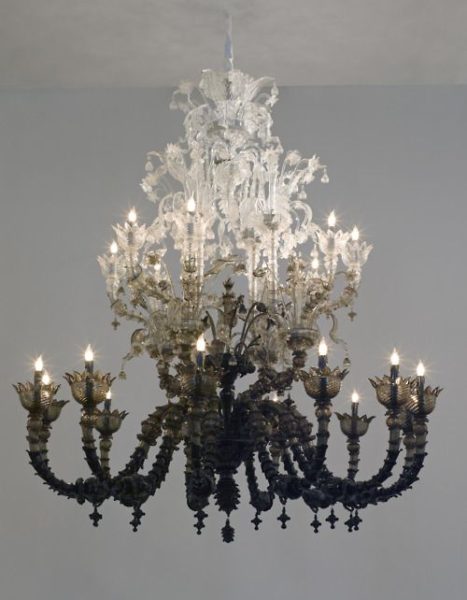
“As juxtaposition is central to my practice, it’s thrilling to see this many of my chandeliers together for the first time since I created and exhibited them, as it’s something I truly never expected to see. These are heavy, fragile, and complex beings that have taken their own shape and meaning over the years. Seeing them from a new perspective, I hope to discover much more about the nuances of the works, all the subtleties and differences. This exhibition provides a rare opportunity for me as an artist to reflect upon the journey thus far while inspiring me to think about what’s next,” Wilson was quoted as saying.
Fred Wilson’s show is up through October 12.
Alexander Calder was the first artist to use wire to create 3D line “drawings” of people, animals, and objects. His “linear sculptures” introduced line into sculpture as an element unto itself. Also on display at Pace are about 70 works by Calder, spanning the 1920s to the 1960s. Collectively the pieces delineate the history of the mobile, which redefined sculpture by introducing (then containing) the element of movement, first through the “performances” of his mechanical “Circus,” later with motorized works, and finally, with his hanging works.
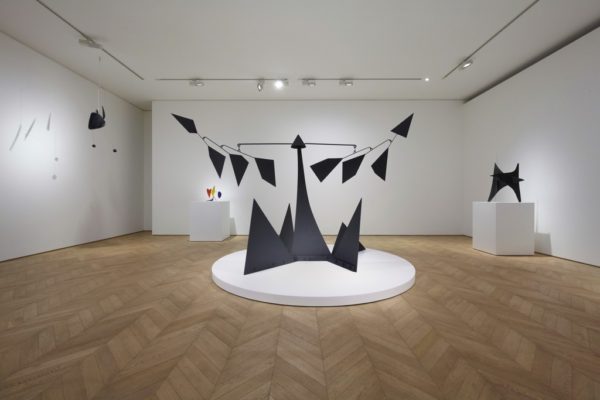
Calder is up through October 26.
Originating in a very personal story, Loie Hollowell’s work explores themes of sexuality through strong allusions to the human form, with an emphasis on the female form. Though abstract, her paintings, characterized by radiating symmetrical silhouettes, a pulsating color palette, and hard geometry, evoke the landscapes and sacred iconography of the body.
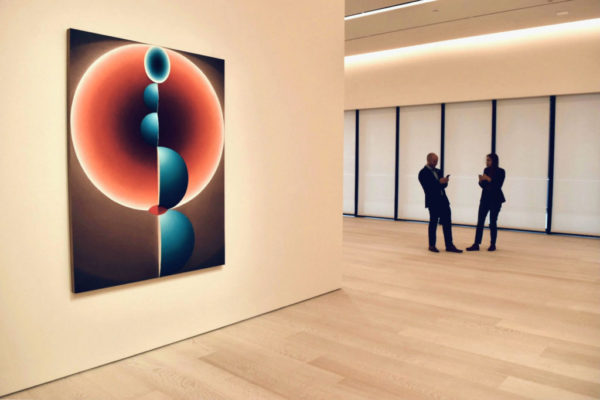
Loie Hollowell’s “Plumb Line” is up through October 19.
David Hockney is one of the most influential British artists of the 20th century, best known for his serial paintings of swimming pools, portraits of friends, and verdant landscapes – like that surrounding his new studio in Normandy. The third floor of Pace’s global headquarters is dedicated to “La Grande Cours, Normandy,” an exhibition of new drawings by Hockney which depicts the arrival of spring in the French countryside. The show marks the first body of work created by the artist at his new space, after which the show is titled.
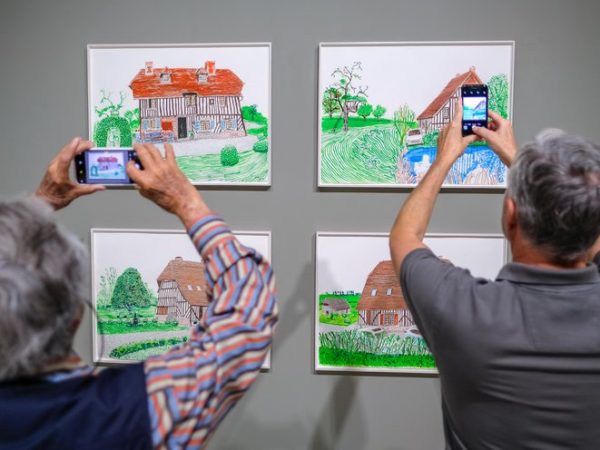
Hockney’s work is up through October 19.
Another of the new Pace’s highlights is a roof terrace on the sixth floor, designed to showcase sculpture by Louise Nevelson, Lynda Benglis, Joel Shapiro, and other greats from the Pace stable.
For more on “Super Pace,” go here.
Other fine fall shows now up in Chelsea include Matt Kleberg at Gemini, 35 West 24 Street, third floor, up through early October. The New York space is hosting Matt’s show for the Hiram Butler Gallery, which is based in Houston, Texas. (At Gemini, there is companion show of classic Claes Oldenberg prints well worth seeing too. Also one of his world-famous Pop sculptures, an oversized ice pack.)
Last Spring we visited Matt in his studio in the Brooklyn Navy Yard, where he was preparing for his testosterone-infused exhibition.

Through the centuries, the depiction of doors and windows in art has resonated with subtext. Portals of all stripes (in this case, literal) variously symbolize a boundary, an escape, a way to new opportunities – or the closing off of potential, a dark menace lurking on the other side. However, sometimes doors and windows really are just doors and windows, beautiful in their patterns, structure, and solidity.
Matt Kleberg’s paintings of abstracted passages in the form of warped prosceniums and archways are largely built with oil sticks which lay down brightly-hued stripes and concentric shapes of ofttimes cacophonous colors. Structurally the artist’s intensely engaging, decorative images walk a tightrope between architectural volume and painterly flatness, pay tribute to one of the artist’s major influences: Frank Stella. However, while honoring his debt to one of the greatest mark makers of the 20th century and beyond, Kleberg takes exception to one of Stella’s most famous dictums: ‘What you see is what you see.” In contrast, he believes:“We can’t escape the world. It is our visual vocabulary.”
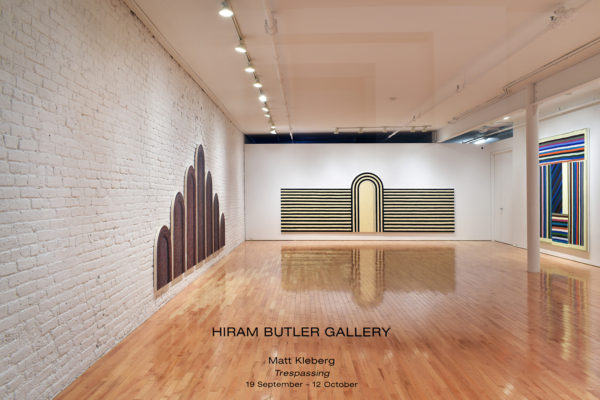
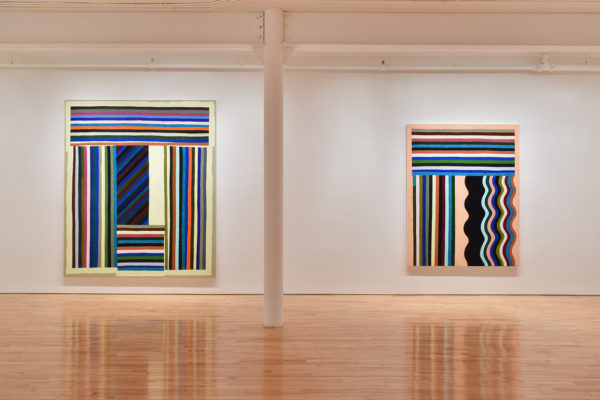
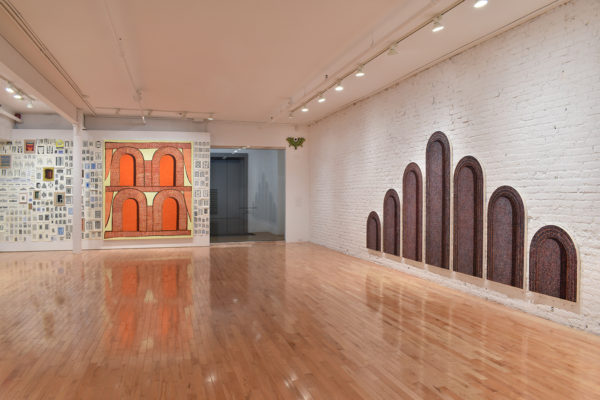
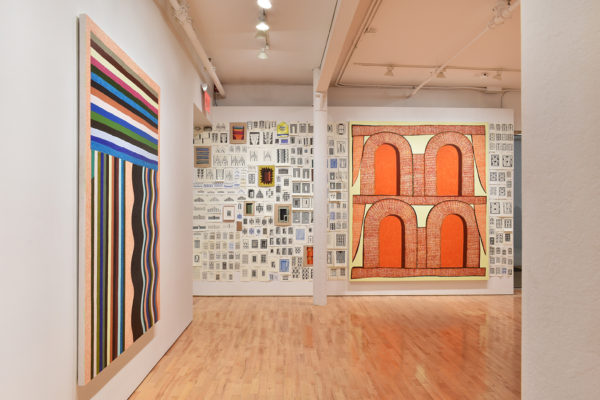
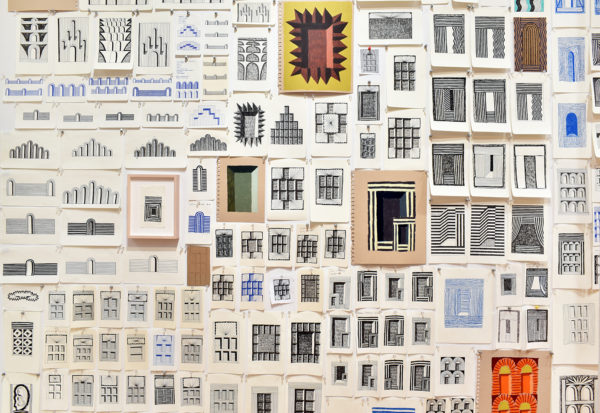
For more from that review of Matt Kleberg’s work (from his 2018 show at Ellen Geldbaugh’s and Catherine Walsh’s On Main in Telluride), go here.
The work of Pop artist Tom Wesselman is up at the Davidson Gallery, 521 West 26 Street.
“Tom Wesselmann: Perfecting the Process,” is a solo exhibition of paintings, drawings, and sculptural works spanning the artist’s acclaimed career.
Wesselmann was the consummate craftsman: the final version of all his major works was preceded by numerous sketches, drawings, maquettes, and studies. This exhibition – Davidson Gallery’s ninth solo show for the artist – features over 24 works, many of which document the steps Wesselmann took before completing an idea.
“Perfecting the Process” takes a broad look across Wesselmann’s nearly 50-year career, examining the way certain themes and subjects recur and connect the decades: nudes, and partial nudes consisting of themed works including lips, hands and feet, as well as still-lifes and smoking themes.

In each work close attention is given to the quality of Wesselmann’s line, the artist’s acute sense of color, and his acknowledged influences including Henri Matisse, Franz Kline, and Willem DeKooning.
Tom Wesselmann was born in Cincinnati, OH, in 1931. He moved to New York City in the 1950s, receiving a degree from the Cooper Union in 1959. In the 1960s, Wesselmann became one of the foremost American Pop artists, working continuously in drawing, painting, assemblage, sculpture, and writing until his death in 2004.
While at Davidson, step out onto its two decks, to check out the kinetic sculpture of Pedro de Movellan and George Rickey – and the views of Chelsea’s spectacular digs.
Wesselmann is up through October 26.
The Kasmin Gallery features the work of Bernar Venet. Consisting of five monumental “Indeterminate Line” sculptures, the show marks Venet’s third solo exhibition withKasmin. It is on view in the gallery’s flagship space, 509 West 27th Street through October 12, 2019. This is the first time the series has been shown in a gallery in the United States since 2002.
“Indeterminate Hypothesis” continues the artist’s lifelong, process-based investigation into the mathematical and philosophical implications of the line. A contemporary of Donald Judd, Dan Flavin, and Sol LeWitt, Venet has concentrated his artistic practice on the complex relationship between an object’s conceptual framework and its materiality for over six decades.
The five abstract “Indeterminate Lines” consist of spiraling rolls of steel that sit, balanced or stacked in novel compositions, on the gallery floor. As well as manifesting the concept of the line as an object—playful, antic, and unpredictable—the series from which these works emerge explores and demonstrates the limits of material resistance.
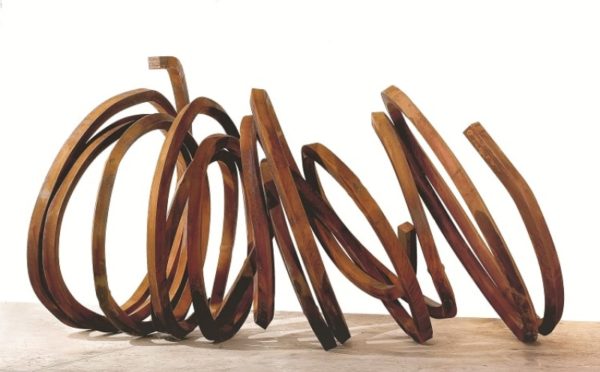
Venet’s physical manipulation of raw bars of steel into unscripted configurations of between one and six elements demands gargantuan effort and reveals the relationship between artist and material as both a collaboration and a battle of wills. The resulting configurations of tightly wound, inextricable loops of industrial material “open a doorway to fundamental principles such as indeterminacy, chance, accident, unpredictability, chaos and, even, incompleteness,” the artist once explained.
Though in a less in-your-face manner, Venet’s art “sculpts” the surrounding space much like the work of Richard Serra, whose series of shows titled “Triptychs & Diptychs,” “Forged Rounds,” and “Reverse Curve,” are on display at the Gagosian galleries,: through November 2 at 980 Madison Avenue; December 7 at 555 West 24 Street; and February 1 at 522 West 21 Street.
Coming of age in the shadow of greats such as Constantin Brancusi, Pablo Picasso, and Julio González, Serra both inherited and advanced the tradition of abstract sculpture, adapting the medium of welded steel to new, holistic values of the 1960s and 1970s. Serra’s art has played a major role in advancing the tradition of modern abstract sculpture in the aftermath of Minimalism.
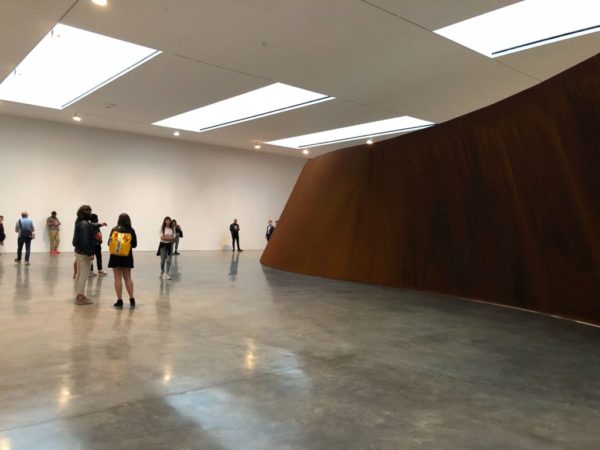
“Weight is a value for me—not that it is any more compelling than lightness, but I simply know more about weight than about lightness and therefore I have more to say about it, more to say about the balancing of weight, the diminishing of weight, the addition and subtraction of weight, the concentration of weight, the rigging of weight, the propping of weight, the placement of weight, the locking of weight, the psychological effects of weight, the disorientation of weight, the disequilibrium of weight, the rotation of weight, the movement of weight, the directionality of weight, the shape of weight,” Richard Serra said.
At 980 Madison Avenue, a series of new diptych and triptych drawings is on view.
Four new works from Serra’s Rounds series fill the entire West 24th Street gallery. Each forged-steel sculpture is composed of multiple, 50-ton elements of differing diameters and heights.
Bisecting the West 21st Street gallery space is Reverse Curve (2005/19), a sculpture measuring 99 feet long and 13 feet high. Originally conceived in 2005 for a public project in Reggio Emilia, Italy, Reverse Curve is finally being realized for the first time.
For the record, Serra’s concern with the implicit relationship between his sculpture’s conception and its intended site has led directly to an international discourse (often heated ) regarding the role of art in public spaces such as parks, corporate plazas, and memorial sites – where the work of art might virtually interrupt viewers’ daily routines in ways that are not necessarily universally welcomed.
Through her portraits, Amy Sherald explores the ways people construct and perform their identities in response to political, social, and cultural expectations.

“…At the Smithsonian unveiling, Michelle Obama and the forty-four-year-old Sherald together pulled down brown wraps to expose a painting of shocking mystery. It is a portrait of the first black First Lady in an abundant gown, designed by one of her favorites, Michelle Smith for Milly Smith, in an interview with Vogue, has said that the dress’s ‘clean, minimal geometric print’ is ‘without a reference to anything past or nostalgic’ and is ‘forward-thinking,’ like Obama herself. But at the lectern, introducing the six-by-five-foot ‘Michelle LaVaughn Robinson Obama,’ oil on linen, 2018,’ Sherald said that the shapes reminded her of Mondrian, and the diligent quilt-making of the black women artisans of Gee’s Bend, Alabama. ‘My approach to portraiture is conceptual,’ she said. Obama herself emphasized that she did not come from the sort of family that had had members sit for portraits. As a variation of the classical American pioneer, she sought out Sherald to translate what being the first meant to her…,” wrote the New Yorker in a profile of the artist in February 2018.
Sherald’s current show,”the heart of the matter…,” is now up at Hauser & Wirth , 548 West 22nd Street, through October 2019.

“If you surrendered to the air, you could ride it,” from 2019.© Amy Sherald. Courtesy the artist and Hauser & Wirth.
“I look at America’s heart — people, landscapes, and cityscapes — and I see it as an opportunity to add to an American art narrative… I paint because I am looking for versions of myself in art history and in the world,” said Sherald.
Sherald’s paintings document the contemporary black experience through arresting, otherworldly portraits. Drawing upon the American Realist tradition, the artist subverts her medium to tease out unexpected narratives and situate black heritage centrally in the story of American art. With ‘the heart of the matter…,’ her inaugural exhibition with Hauser & Wirth, Sherald debuts a suite of new paintings that reinforces the wide range of African-American life and invites viewers to reconsider commonly accepted notions of race and representation.
For more, read Peter Schjeldahl’s review, another story from The New Yorker.
Also Hauser & Wirth through October is the work of painter Ed Clark. Over the course of seven decades, Clark’s experimentations with pure color, abstract form, and the seductive materiality of paint have yielded an oeuvre of remarkable originality, extending the language of American abstraction.
Clark is regarded as a pioneer of the New York School and a formative addition to the group of abstract artists working in the post-war WWII era. His use of the push broom creates compositions that straddle the line between Abstract Expressionism and Color Field painting best summed up as a unique form of expressionism.
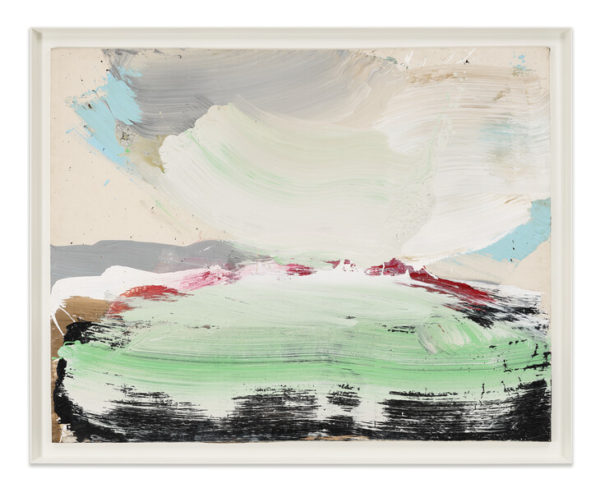
Lyons Wier Gallery features Michelle Doll’s latest solo exhibition titled “As Above, So Below” through September 28.
Doll’s meticulous and lovingly rendered figures represent the familiar touch between a couple, the closeness between a mother and child, and intimate moments of ecstatic love.
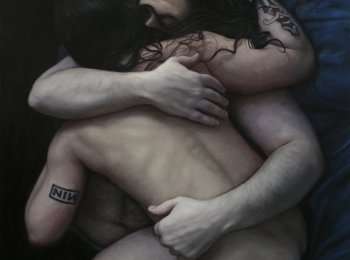
Her models are her close friends and family and the requisite trust and vulnerability between the artist and her subjects is palpable in her compositions. These are real couples sharing moments of real love and tenderness with the artist, (and her audience).
As Doll explains, “I want to live in a world where women and men feel loved, understood and nurtured by both giving and receiving love. Where intimacy feels natural and acceptable, it’s the starting point for the greater understanding of human desire for acceptance and connection.”
DC Moore Gallery, 535 West 22 Street, features the work of Yvonne Jacquette and a selection of drawings, paintings, and prints by George Tooker, through October 5.
In this new series, Jacquette directly examines the rapidly changing structure of the city, paying close attention to minute architectural details, and often including construction apparatuses and equipment. Because she lives in East Chelsea, the artist easily takes her inspirations from the continual changes in her ‘hood.
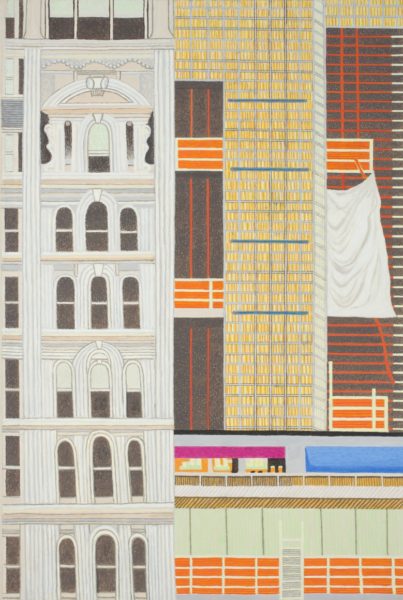
“George Tooker: Contemplative Gaze,” features a selection of paintings, drawings, and prints. Tooker (1920-2011) painted in egg tempera. Due to the care required in his process, the thorough and precise application the medium demanded, he was not a prolific painter. Tooker is most often described as a Magic Realist, though he and his good friend Paul Cadmus preferred the designation “Symbolic Realist.”
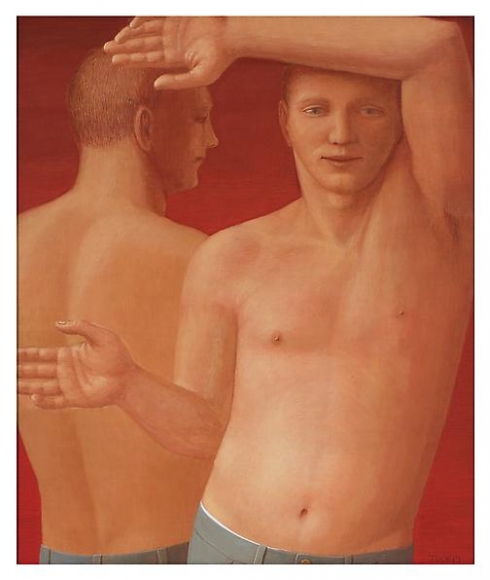
A new exhibition at the Marlborough Gallery, 40 West 57th Street, “Sculpture and Drawings: 1996 – 2017,” features the work of Tom Otterness through October 12.
Otterness’s well-known and endlessly inventive sculptural creations have made him one of the most popular American artists of the day. His signature figures — Cones, Spheres, and Cylinders, honoring Cezanne, a father of modernism, who was quoted as saying “Treat nature in terms of the cylinder, the sphere and the cone” — are presented in a wide range of sculptural situations. The shapes have the effect of universalizing form, yet they are remarkably expressive. Each is recognizably his own creation and at the same time reflective of art history, fables, allegories, even current events.
“Kissing Dung Beetles,” (2007), a seven-foot tall bronze, is, according to Otterness, “an optimistic spin on Kafka’s The Metamorphosis.” Here the multi-legged male and female beetles are embracing atop a moneybag, a frequent object in the artist’s oeuvre. He continues, “It’s very passionate….Whether they are in love with each other or the money is in question, but they are happy.”
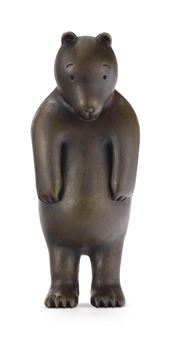
In addition to his beloved “Kissing Cones” and “Kissing Spheres,” many of the artist’s animal sculptures are on display. Denizens of the animal kingdom from a lioness to a mouse are a part of the exhibition, as well as several incarnations of his celebrated bears. Drawings in pencil are also highlights. Beginning in 2015, Otterness began making drawings on treated paper with silverpoint, the metallic stylus favored by Leonardo da Vinci.
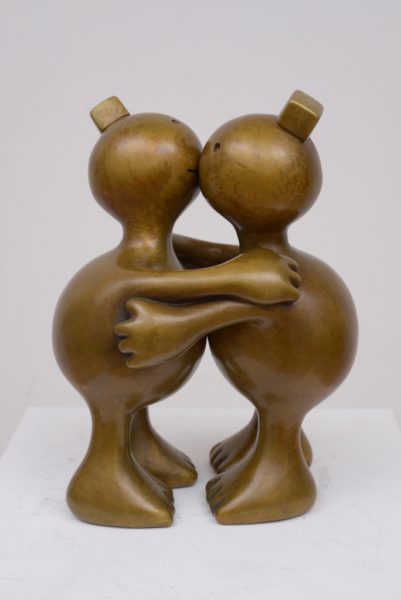
Sculptures by Tom Otterness are in the collections of numerous museums including The Museum of Modern Art, New York; The Whitney Museum of American Art, New York; Israel Museum, Jerusalem; The Miyagi Museum of Art, Senda; Beelden aan Zee Museum, The Hague; and Institut Valencia d’Art Modern (IVAM) Centro Julio Gonzalez, Valencia.
Commissioned public art projects have included the United States courthouses in Minneapolis and Sacramento, an extensive installation at the governor Nelson A. Rockefeller Park in Battery Park City,” Life Underground,” over 100 iconic sculptures installed throughout the 14th Street subway station in New York City.
“Paris, Capital of Fashion” is the first exhibition to explore the cultural construction of Paris as the capital of fashion. Curated by Dr. Valerie Steele, director of The Museum at FIT, the show features approximately 100 objects dating from the 18th Century to the present. At Seventh Avenue at 27th Street and up through January 4, 2020,

Across the street from the FIT Museum, “Disney on Broadway” continues its 25th anniversary celebration in partnership with the Fashion Institute of Technology, creating a unique design challenge for students to reimagine contemporary designs for some of Disney shows on Broadway’s iconic female characters. The partnership is a first between Disney on Broadway and the college, which is celebrating its 75th anniversary.
The student finalists, who are from all over the world, have their garments on display in an exhibition at the Art and Design Gallery located in FIT’s Pomerantz Art and Design Center through October 6.
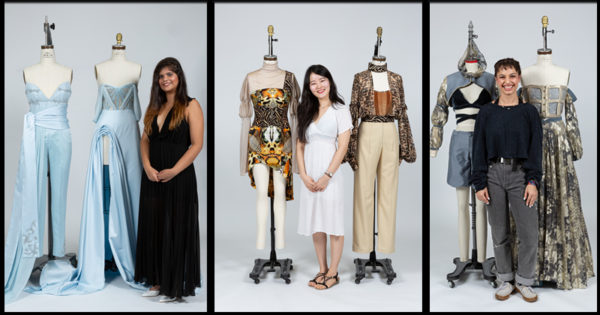
Broadway: “Hadestown” & “Betrayal”:
“Hadestown” is, ahem, a very hot musical by celebrated singer-songwriter Anaïs Mitchell and director Rachel Chavkin (“Natasha,” “Pierre & The Great Comet of 1812”). It is a love story for today… and always, read no Hollywood ending.
“Hadestown” intertwines two mythic tales — that of young dreamers Orpheus and Eurydice, and that of King Hades and his wife Persephone — as it invites you on a hell-raising journey to the underworld and back. Mitchell’s beguiling melodies and Chavkin’s poetic imagination pit industry against nature, doubt against faith, and fear against love. Performed by a vibrant ensemble of actors, dancers and singers, ‘Hadestown’ is a haunting and hopeful theatrical experience that grabs you and never lets go,” says the promo.
Heavenly music and dancing and an orchestral landscapes that is all American: folk, jazz, blues, pop, Dixieland, and Americana, “Hadestown” rocks. Arguably the best company of singers and dancers on Broadway today. Go!
And here is a full review from Rolling Stone. It was written by a guy whose last name is Hermes, making it impossible not to feature his words in this context. (Plus we agree with his insights.)
If “Hadestown” trends over the top to Dionysian maximalism – and it does in every way (production, performances, etc.) – then the current production of “Betrayal” screams Spartan minimalism.
Harold Pinter famously reverses chronology so that we start with the bitter-sweet aftertaste of an affair, then moonwalk back in time to its beginnings. But director Jamie Lloyd never lets us forget that there are three sides to every emotional triangle and that the absent partner is always a ghost in the room, there in the mind if not in fact. They also haunt Pinter’s signature pregnant pauses.
“Betrayal” is as a stunning as a Hopper painting. It is filled with as much loneliness and longing, only with pauses that refresh – the laughter of a child when she is tossed in the air; an exchange with a stereotypical Italian waiter over lunch. But those parentheses, those calms between the storms, those light interludes, serve to make the darkness darker. The three actors are allowed run (on), but no one can hide – not even from themselves. (As we can’t really hide from ourselves.)
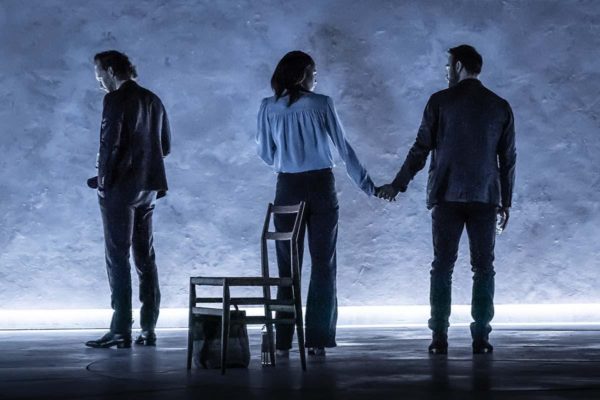
Here is a full review from The New York Times.


Sorry, the comment form is closed at this time.